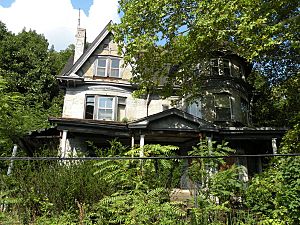National Negro Opera Company facts for kids
|
Pennsylvania Historical Marker
|
|

The National Negro Opera Company House
|
|
| Location | 7101 Apple Street, Homewood West neighborhood of Pittsburgh, Pennsylvania |
|---|---|
| Coordinates | 40°27′51″N 79°53′45″W / 40.4642°N 79.89571°W |
| Built/founded | House: 1908 Company: 1941 |
| Architectural style(s) | Queen Anne style |
| Governing body/ |
Jonnet Solomon-Nowlin & Miriam White |
| PHMC dedicated | September 25, 1994 |
| CPHD designated | May 20, 2008 |
The National Negro Opera Company (NNOC) was a very important group in American history. It was the first African-American opera company in the United States. This amazing company performed from 1941 to 1962.
It was started in Pittsburgh, Pennsylvania, by a talented woman named Mary Cardwell Dawson. The company's first show was at the local Syria Mosque. Famous singers like La Julia Rhea, Minto Cato, Carol Brice, Robert McFerrin, and Lillian Evanti performed with the NNOC. Over 21 years, the company also put on shows in Washington D.C., New York City, and Chicago. The company stopped performing in 1962 after Mary Cardwell Dawson passed away.
Contents
The Opera Company's Home
Even though the company traveled all over the country, its main offices and practice studios were in a special house. This house is a three-story building in the Queen Anne style. It is located at 7101 Apple Street in Pittsburgh's Homewood neighborhood.
History of the House
The building was first built as a private home in 1908. In the 1930s, a man named William A. "Woogie" Harris bought it. He was the brother of the famous photographer Charles "Teenie" Harris. The NNOC moved its main operations to Washington, D.C. in 1942. However, they continued to use the third floor of the Apple Street house. It served as a local office and studios until the company closed.
Mystery Manor: A Special Place
After the opera company left, the building became a social center and a place for people to stay. It was known as Mystery Manor. This house often hosted famous celebrities and athletes who were visiting. At that time, many hotels were segregated, meaning they would not allow African-American guests. Mystery Manor provided a safe and welcoming place for these important visitors.
Preserving a Landmark
The house on Apple Street is a very important historical site. In 1994, the Pennsylvania Historical and Museum Commission officially named it a historic structure. Later, in 2008, it became a Pittsburgh City Historic Landmark.
The Young Preservationists of Pittsburgh group has also recognized the building's importance. They included it on their "Top 10" list of preservation opportunities in 2003 and again in 2013.
In 2000, two Pittsburgh residents, Jonnet Solomon and Miriam White, bought the house. They had plans to turn the historic building into a museum and arts center. However, the building still needs a lot of work. In 2020, the National Trust for Historic Preservation added the building to its list of America’s 11 Most Endangered Historic Places. This shows how important it is to save this piece of history.


